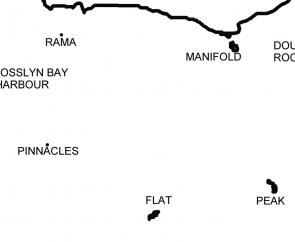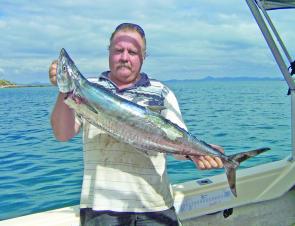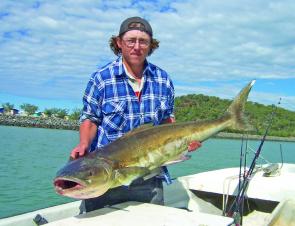All the locals here are eager to get among the big fish offshore but the odd opportunity that has come up isn’t yielding any worthwhile results.
We went straight from flood conditions into a long run of high winds, which keep the offshore rough and the inshore waters choppy and dirty. The school mackerel have bypassed Keppel Bay favouring the cleaner waters up along the shoals instead of the coast. The bottom bashers in the form of reefies are, however, coming in to closer grounds after the prawns and small baitfish were washed out of the estuary systems.
Just lately there has been a stack of smallmouth and largemouth nannygai in The Pinnacles area including The Rama and Flat Island. Findlay’s and Forty Acre Paddock turn on and off at a moments notice so it pays to drop an exploratory bait on the way past if you are heading to wider locations. In the south of the bay is the Liza Jane Patch, which is a special for nannies.
The average fish caught in close is 2-3kg while bigger species around 12-15kg can be found at the wider spots. These redfish have not been phased by the off colour water and probably came in larger numbers than previous years, particularly since 2004. We normally catch these fellows on the rubble patches and low, reefy structures more often than the higher peaks. They generally feed in the middle ground between the reefy peaks and the deeper troughs where the big grunter are found. These guys respond well to berley and are among the first fish to investigate a food source.
Look at the fish finder to find the school when fishing the wider grounds but at places like Liza Jane and The Pinnacles it is best to pick some good country, anchor up and drop the berley bomb down. When they are near a significant structure they move right around the structure circling until they find a feed. A variety of rigs work well for red jew, anything from the standard snapper rig, a ball sinker just above the hook, to a short leader should do the trick. Flesh baits, pilchards and squid are the most popular baits here mainly because they are easy to obtain.
The best tasting fish are smaller to average sized fish; the really big fish are moderately strong flavoured and appeal more to those who prefer a heavier fish taste. Largemouth are the more popular of the two as a table fish. Try baking either of them whole, stuffed with shallots, bacon, capsicum, a few prawns and a squeeze of lemon, smeared with a light garlic butter wrapped in foil. Add a tablespoon of a nice white wine before closing the foil. Preheat the oven at 200 degrees. Place the fish in and check it at 30 minutes by pushing a fine skewer through the fish; when it passes through without resistance it is cooked. Its so easy, tastes great and will impress your mates.
Trevally are here en masse at present, particularly at The Pinnacles where they can become very annoying when you are after better fish. On saying that, they are up there with the best as a sports fish on light gear. Trevally will take livies, pillies, flesh baits and squid but the most fun is with lures or jigs. Trevally will circle the higher structure often grabbing floated pilchards meant for mackerel. They don’t have the same appeal as a table fish so they can be despised. We have found if they are bled properly on capture, instead of the Iki Jima method, and eaten that day they taste much better. There is no need to cut right through the throat, this only allows more bacteria to get in. One knife insertion directly into the white covered blood bag under the back edge of the gill plate, right in front of the pectoral fin should suffice. This will bleed all types of fish.
Some fish are better killed using Iki Jima and some aren’t. Fish like whiting, flathead and bream seem to stay good anyway. Iki Jima is the insertion of a spike directly into the brain causing immediate brain death while still alive. All fish should be chilled in ice slurry immediately after it has been pierced. Iki Jima also slows down rigor mortis and preserving the quality of the flesh. The brain of the fish is in a different spot in some species so it might pay to find where it is first in each type of fish in order to perform this method effectively.
North of Yeppoon we have an area that is rich with different species of fish, starting at about 37km. There are a few major spots there that get a work over from time to time and still keep producing. The first one is The Rama, which is a wreck that is well known for big grunter, nannies and trevally. This spot does best over the full moon as a rule and over the black nights. Five Rocks also produces and is accessible from land or water.
The beach has a great reputation for whiting, salmon and the biggest beachworms to be found anywhere. The rocks themselves can turn out anything from barramundi, sweetlip, cod, queenfish, salmon, tuna, all the mackerels and even painted crayfish if you are game enough to snorkel there (some huge tigers have been sighted cruising these waters). Out from the rocks there is a depth change that always has a big Spanish or two when other places are slow.
The Pinnacles are one of the most consistent spots to nail a feed most of the year. They can fire up for Spanish mackerel, trevally, black jew, grunter, snapper and a swag of reefies including sweetlip and coral trout. I like to fish there at night when the water absolutely boils with all sorts of stuff. Last year I landed a tarpon weighing 4.5kg, which is miles bigger than the estuary specimens that average about 1-2kg. One particular night I only used shiny lures, mostly Flashas and Raiders, catching and releasing amberjack and the usual trevally.
Flat and Peak islands are locally renowned for their reefies and big Spanish mackerel, and are often the starting point for the newbies before venturing further out. Manifold has the supply of Spanish nearly all year and when the water around The Keppel’s is a bit off colour you can score them up here in pristine waters.
Grunter, black jew and snapper are other regulars making Manifold a great place for anglers who like to keep land in sight.
Double Rock is a phenomenon: when the fish are on they are really on and you need your biggest gear to land any of the Spanish and black jew here. I have never heard of small fish being landed here usually because they get eaten before getting boated.
Facts
Distances from Rosslyn Bay Harbour
| Rama: | 37km |
|---|---|
| Pinnacles: | 38km |
| Five Rocks: | 40km |
| Flat: | 51km |
| Manifold: | 52km |
| Peak: | 57km |
| Double Rocks: | 58km |

Pinnacle area map. The Pinnacles are one of the most consistent spots to nail a feed most of the year.

Mark Buckby with a wonderful jack caught on a soft plastic.

Scott lynch with a spanish caught at Man and Wife.

Luke MacLennan caught this cobia at The Pinnacles.

Graham Edmunds with a snapper caught out behind Keppel’s.




